
Year 632 (DCXXXII) was a leap year starting on Wednesday of the Julian calendar. The denomination 632 for this year has been used since the early medieval period, when the Anno Domini calendar era became the prevalent method in Europe for naming years.

Year 567 (DLXVII) was a common year starting on Saturday of the Julian calendar. The denomination 567 for this year has been used since the early medieval period, when the Anno Domini calendar era became the prevalent method in Europe for naming years.
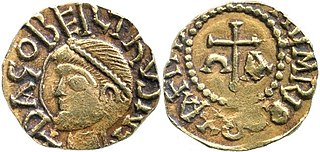
Dagobert I was King of the Franks. He ruled Austrasia (623–634) and Neustria and Burgundy (629–639). He has been described as the last king of the Merovingian dynasty to wield real royal power. Dagobert was the first Frankish king to be buried in the royal tombs at the Basilica of Saint-Denis.

Chlothar II, sometimes called "the Young", was king of the Franks, ruling Neustria (584–629), Burgundy (613–629) and Austrasia (613–623).
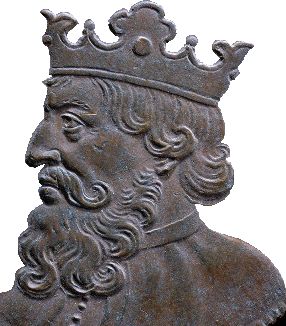
Chilperic I was the king of Neustria from 561 to his death. He was one of the sons of the Frankish king Clotaire I and Queen Aregund.
Charibert is a Frankish given name meaning "glorious warrior". The name Berthar contains the same two elements in reversed order. It is the same name as Herbert, Heribert and Aribert.
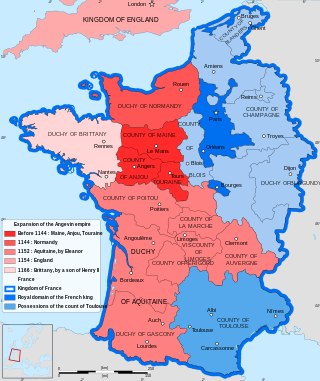
The Duke of Aquitaine was the ruler of the medieval region of Aquitaine under the supremacy of Frankish, English, and later French kings.
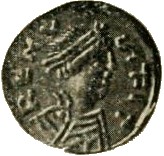
Sigebert I was a Frankish king of Austrasia from the death of his father in 561 to his own death. He was the third surviving son out of four of Clotaire I and Ingund. His reign found him mostly occupied with a successful civil war against his half-brother, Chilperic.

Bertrada of Laon, also known as Bertrada the Younger or Bertha Broadfoot, was a Frankish queen. She was the wife of Pepin the Short and the mother of Charlemagne, Carloman and Gisela, plus five other children.

Charibert I was the Merovingian King of Paris, the second-eldest son of Chlothar I and his first wife Ingund. His elder brother Gunthar died sometime before their father's death. He shared in the partition of the Frankish kingdom that followed his father's death in 561, receiving the old kingdom of Childebert I, with its capital at Paris.
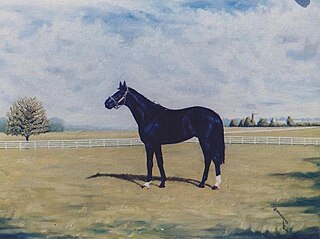
The July Cup is a Group 1 flat horse race in Great Britain open to horses aged three years or older. It is run on the July Course at Newmarket over a distance of 6 furlongs, and it is scheduled to take place each year in July.

Charibert II, a son of Clotaire II and his junior wife Sichilde, was briefly King of Aquitaine from 629 to his death, with his capital at Toulouse. There are no direct statements about when Charibert was born exactly, the only known fact being that he was "a few years younger" than his half-brother Dagobert. His father Clotaire evidently had a bigamous marriage and he was the offspring of the junior wife.
Charibert, Count of Laon, was the maternal grandfather of Charlemagne. Charibert was the father of Charlemagne's mother, Bertrada of Laon.

Bertrada, also called Berthe or Bertree, is known to be the mother of Charibert of Laon, with whom she is co-founder and benefactor of the Prüm Abbey. They founded the abbey in 721.
Felix was a patrician in the Frankish kingdom under the Merovingians. He had his seat at Toulouse. According to the tenth-century Miracula sancti Martialis lemovicensis, Felix was "a noble and renowned patrician from the town of Toulouse, who had obtained authority over all the cities up to the Pyrenees and over the iniquitous people of the Wascones," that is, the Basques. Felix is probably the first ruler of the Duchy of Aquitaine that evolved from the old kingdom of Charibert II in the decades following his death (632) and Dagobert I's subjection of the Basques. Although he stands at the head of the list of semi-independent rulers of Aquitaine that extends through the Middle Ages, he is described as "mysterious" and "obscure".

The Basilica of Saint-Romain, Blaye, was an important Merovingian basilica, the resting-place of Charibert II, a son of Clotaire II who was briefly king of Aquitaine from 629 to his death in 632, and of his son. According to the 12th-century Chanson de Roland contained the body and relics of the Carolingian folk-hero Roland, who was a seigneur of Blaye in the eighth century, and of his companions Olivier and Turpin, deposited with grand solemnity in white marble sarcophagi. In Bordeaux across the Gironde the oliphaunt, Roland's split ivory horn, was preserved: li pelerin li veient ki la vunt, "the pilgrim may see it who goes"; a Seint Romain; la gisent li baron, "at Saint-Romain; there lie the barons", a sign interpreted by Gerald Brault to show that the pilgrimage sites at Bordeaux and Blaye had been established before the Chanson de Roland was composed. Indeed, in 1109 Hugh of Fleury concluded his account of the battle of Roncevaux with the words "whence Roland was carried to the citadel of Blaye and buried." The legend was long credited: in 1526 François I commanded the tomb of Roland to be opened.
Heraclius was Bishop of Angoulême. The main source about his life is the Historia Francorum of Gregory of Tours.
Charibert de Haspengau (555–636) was a Frankish nobleman, possibly a comes. The identity of his parents is uncertain, though he is believed by some to be the son of King Charibert I of Paris. Charibert is described as Charibert nobilis in Neustria. No other information is available other than descriptions of his grandchildren, who are described as having "high rank and worthy of significant positions" within the palace.

Theudechild was a Frankish queen consort by marriage to king Charibert I.















